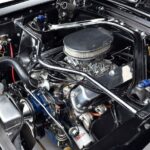Imagine the frustration: your car’s check engine light illuminates, casting a shadow of uncertainty and potential expensive repairs. Many car owners have faced the daunting experience of hefty repair bills, sometimes for issues that weren’t even accurately diagnosed initially. This is where a car diagnostic scanner, often referred to as an OBD2 scanner or code reader, becomes an invaluable tool. It empowers you to understand your vehicle’s health and potentially save significant money and time on car repairs.
What Exactly is a Car Diagnostic Scanner?
A car diagnostic scanner is essentially a communicator with your car’s onboard computer. Since 1996, it’s been mandatory in North America for every car, light truck, SUV, minivan, and hybrid to have an On-Board Diagnostics (OBD2) system. According to Keith Andreasen, a master technician certified by Automotive Service Excellence (ASE) and product manager at Innova Electronics, this system is designed to monitor vehicle systems that trigger the check engine light. Its primary function is to alert drivers to problems related to emissions, fuel efficiency, and overall vehicle performance.
An image showing the typical location of an OBD2 port under the steering wheel in a car.
In simpler terms, a car diagnostic scanner is your personal interpreter for your car’s warning signals. It allows both DIY enthusiasts and professional mechanics to pinpoint what’s ailing a vehicle. While basic scanners simply read error codes, more advanced models can monitor real-time data, offering a deeper dive into your car’s operational status. Regardless of complexity, all OBD2 devices connect to a standardized port, usually found conveniently under the steering wheel.
Unlocking the Potential: What Can a Diagnostic Scanner Do?
At the core of a diagnostic scanner’s capability is its ability to read Diagnostic Trouble Codes (DTCs). These codes are generated by your car’s computer when it detects an issue. Andreasen explains that the scanner translates these codes into an understandable format, helping users identify the area of the problem.
Beyond just reading codes, a car diagnostic scanner offers a range of functionalities:
- Clearing Trouble Codes: Once a repair is completed, a scanner can clear the DTCs, effectively turning off the check engine light, tire pressure sensor light, and other warning indicators.
- Real-Time Data Monitoring: Scanners can display live data from various sensors and systems, such as engine RPM, vehicle speed, coolant temperature, and oxygen sensor readings. This real-time insight is crucial for diagnosing intermittent problems.
- Freeze Frame Data Retrieval: This feature captures a snapshot of your vehicle’s system parameters at the exact moment a trouble code was triggered. It provides valuable context for understanding the conditions when the problem occurred.
- Live Data Stream Viewing: Advanced scanners can display live data streams from multiple sensors simultaneously. This is essential for diagnosing complex issues arising from interactions between different vehicle systems.
- Emissions Test Readiness Check: Many scanners can indicate whether your vehicle is likely to pass an upcoming emissions test, saving you potential headaches and re-test fees.
- Vehicle Information Retrieval: Scanners can access important vehicle information like VIN numbers and system calibration details.
- Active Tests (Bi-Directional Controls): More sophisticated scanners allow you to send commands to your vehicle’s systems and components to perform active tests. This can help isolate issues by directly interacting with specific parts.
- Software Updates: Some advanced scanners even facilitate software updates for your vehicle’s computer systems.
A close-up image of a dashboard with the check engine light illuminated.
Understanding Limitations: What a Scanner Can’t Do
While car diagnostic scanners are powerful tools, it’s important to have realistic expectations. Regardless of price or manufacturer, OBD2 devices generally cannot:
- Physically Repair Your Car: A scanner identifies the problem, but it doesn’t fix it. Mechanical repairs still require manual intervention.
- Predict Future Failures: Scanners diagnose current issues, not future ones. Although, when used with certain databases and apps, they can offer insights into potential problems based on historical data and common failure patterns.
- Diagnose Non-Electrical Problems: Scanners are designed for electrical and electronic system diagnostics. They won’t detect mechanical issues like worn tires, a failing water pump, or fuel quality problems.
- Override Safety Systems or Manufacturer Settings: Scanners are diagnostic tools, not reprogramming devices. They cannot bypass safety features or alter factory settings.
- Replace Regular Maintenance: Scanners are supplementary tools, not substitutes for routine maintenance like oil changes and fluid checks.
- Provide Detailed Mechanical Diagnosis: As Andreasen points out, “While scanners can highlight areas of concern, they might not offer detailed explanations for the root cause.” Further investigation by a mechanic might be needed for complex mechanical failures.
Who Benefits Most from a Car Diagnostic Scanner?
A car diagnostic scanner is a valuable asset for anyone who enjoys basic car maintenance and wants to understand their vehicle better. It empowers you to troubleshoot issues before automatically resorting to expensive professional repairs.
Andreasen notes, “Even someone with limited automotive experience can use a diagnostic scanner to assess a vehicle’s readiness for a road trip, check emissions test readiness, or gain a clearer understanding of why the check engine light is on.”
For those considering purchasing a scanner, there are options for every level of user, from entry-level models to more advanced professional-grade tools. And if you’re hesitant to buy one immediately, most auto parts stores offer free basic code reading services, providing a starting point for understanding your car’s diagnostic codes.
By understanding what a car diagnostic scanner is and what it can do, you can take a more proactive and informed approach to car maintenance, potentially saving money and gaining valuable insight into your vehicle’s inner workings.

